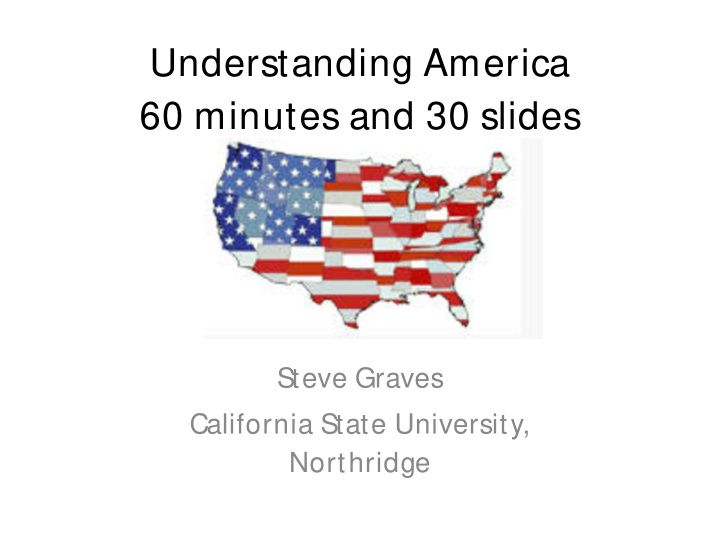



Understanding America 60 minutes and 30 slides Steve Graves California State University, Northridge
Three, Four or T en Americas? • The United States, like China, has multiple divisions. • United by a common language, but divided by significant differences in political values and cultural assumptions. • Three main groups: – Y ankees – M iddle Americans – Southerners
The Nine Nations of North America
The Nine Nations of China?
Y ankees • Settled by religious, industrious, communally- minded English persons. • Were fortunate to find ample water power and so this region industrialized earlier than other regions of the United States. • Industrialization attracted waves of immigrants from Europe to these areas.
T own Commons
Water M ill
Boston – Y ankee Capital
New Englanders
Implications? • These areas tend to be most open to immigration, cultural change and innovation. • Both manufacturing and high tech industry. • Also tend to favor government involvement in business, the environment and cultural issues. • Higher taxes, but also highest quality of life. Best schools, hospitals, income, parks, etc. • Larger middle classes. M ore unions. Less poverty. • Large population; politically powerful… but not as powerful since the 1980s. • Favor Obama and other liberal politicians.
Southerners • Culture largely established by English and Africans. • Had no water power during 1700-1850s, so remained largely agricultural until 20 th century. • Embrace traditional ways • Far fewer immigrants than the North. • Defeated in the Civil War. Bitterness, distrust and rivalry remain still today (150 years later).
Cotton Plantation
Deep South
Atlanta Capital of the New South
Southerners?
Implications • Tradition! Less open to cultural change, immigration and new ideas… conservative and highly religious • Large black populations in old slave areas, but few blacks in mountainous regions of the South. • T ensions remain between blacks and whites, but they share many traditional cultural values. • Favor smaller government since 1960s, though more dependent on Federal government programs for help than other parts of the US. • Distrust government, especially Federal government, “interference” in local affairs, especially on cultural and social matters. • Small middle class and much poverty. • Growing population and power since 1980… more industrialization thanks to aggressive tax incentives and lax environmental enforcement.
M iddle Americans • Large immigrant populations, but mostly from Germany and Scandinavia. Far fewer Blacks and Southern & Eastern Europeans… until 1900s and mostly in cities. • Religious, but far more independent and individualistic. Protestants mostly, but Catholic dominate cities. • The agricultural heartland, but small holders unlike the plantation system that dominated the South. • M assive industrialization in urban areas… particularly Chicago, Detroit, Cleveland, M ilwaukee, areas. • Includes most of the people in Pennsylvania, Ohio, Indiana, Illinois, Iowa, M issouri, Kansas, Nebraska and into Colorado. • M uch of California as well…
Small T own M idwest
The Dying Factory-Farm T own
Fields and Factories
Chicago – Farms and Factory Capital
M idwesterners
Implications • M iddle Americans are most average culturally and politically. • They favor smaller government, but not because of distrust or suspicion, but out of a belief in the power of local communities and/or individuals are better suited to accomplish goals. • Stuck in the middle of the cultural wars between Southerners and Y ankees – “ Swing States”
Westerners • Those people in the remaining areas are fewer in number and power. (Wyoming has .5 million) • Religious minorities, like M ormons occupy Utah, Idaho and some of Nevada. • New M exico is poor, barren and Hispanic. • Arizona is similar to New M exico, but with a larger immigrant population from M idwest and California. M any retirees. • Extreme politics and cultural behaviors stemming from religious beliefs, isolation, resentment of government regulation of natural resources (forests, mining, rangelands)
No Speed Limit
M yth and Reality
Recommend
More recommend